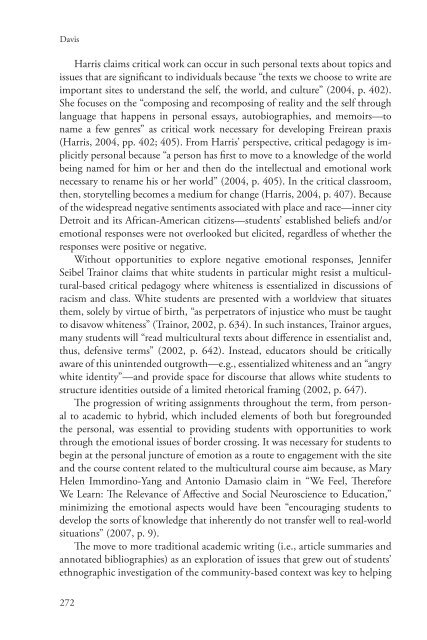Critical Expressivism- Theory and Practice in the Composition Classroom, 2014a
Critical Expressivism- Theory and Practice in the Composition Classroom, 2014a
Critical Expressivism- Theory and Practice in the Composition Classroom, 2014a
Create successful ePaper yourself
Turn your PDF publications into a flip-book with our unique Google optimized e-Paper software.
Davis<br />
Harris claims critical work can occur <strong>in</strong> such personal texts about topics <strong>and</strong><br />
issues that are significant to <strong>in</strong>dividuals because “<strong>the</strong> texts we choose to write are<br />
important sites to underst<strong>and</strong> <strong>the</strong> self, <strong>the</strong> world, <strong>and</strong> culture” (2004, p. 402).<br />
She focuses on <strong>the</strong> “compos<strong>in</strong>g <strong>and</strong> recompos<strong>in</strong>g of reality <strong>and</strong> <strong>the</strong> self through<br />
language that happens <strong>in</strong> personal essays, autobiographies, <strong>and</strong> memoirs—to<br />
name a few genres” as critical work necessary for develop<strong>in</strong>g Freirean praxis<br />
(Harris, 2004, pp. 402; 405). From Harris’ perspective, critical pedagogy is implicitly<br />
personal because “a person has first to move to a knowledge of <strong>the</strong> world<br />
be<strong>in</strong>g named for him or her <strong>and</strong> <strong>the</strong>n do <strong>the</strong> <strong>in</strong>tellectual <strong>and</strong> emotional work<br />
necessary to rename his or her world” (2004, p. 405). In <strong>the</strong> critical classroom,<br />
<strong>the</strong>n, storytell<strong>in</strong>g becomes a medium for change (Harris, 2004, p. 407). Because<br />
of <strong>the</strong> widespread negative sentiments associated with place <strong>and</strong> race—<strong>in</strong>ner city<br />
Detroit <strong>and</strong> its African-American citizens—students’ established beliefs <strong>and</strong>/or<br />
emotional responses were not overlooked but elicited, regardless of whe<strong>the</strong>r <strong>the</strong><br />
responses were positive or negative.<br />
Without opportunities to explore negative emotional responses, Jennifer<br />
Seibel Tra<strong>in</strong>or claims that white students <strong>in</strong> particular might resist a multicultural-based<br />
critical pedagogy where whiteness is essentialized <strong>in</strong> discussions of<br />
racism <strong>and</strong> class. White students are presented with a worldview that situates<br />
<strong>the</strong>m, solely by virtue of birth, “as perpetrators of <strong>in</strong>justice who must be taught<br />
to disavow whiteness” (Tra<strong>in</strong>or, 2002, p. 634). In such <strong>in</strong>stances, Tra<strong>in</strong>or argues,<br />
many students will “read multicultural texts about difference <strong>in</strong> essentialist <strong>and</strong>,<br />
thus, defensive terms” (2002, p. 642). Instead, educators should be critically<br />
aware of this un<strong>in</strong>tended outgrowth—e.g., essentialized whiteness <strong>and</strong> an “angry<br />
white identity”—<strong>and</strong> provide space for discourse that allows white students to<br />
structure identities outside of a limited rhetorical fram<strong>in</strong>g (2002, p. 647).<br />
The progression of writ<strong>in</strong>g assignments throughout <strong>the</strong> term, from personal<br />
to academic to hybrid, which <strong>in</strong>cluded elements of both but foregrounded<br />
<strong>the</strong> personal, was essential to provid<strong>in</strong>g students with opportunities to work<br />
through <strong>the</strong> emotional issues of border cross<strong>in</strong>g. It was necessary for students to<br />
beg<strong>in</strong> at <strong>the</strong> personal juncture of emotion as a route to engagement with <strong>the</strong> site<br />
<strong>and</strong> <strong>the</strong> course content related to <strong>the</strong> multicultural course aim because, as Mary<br />
Helen Immord<strong>in</strong>o-Yang <strong>and</strong> Antonio Damasio claim <strong>in</strong> “We Feel, Therefore<br />
We Learn: The Relevance of Affective <strong>and</strong> Social Neuroscience to Education,”<br />
m<strong>in</strong>imiz<strong>in</strong>g <strong>the</strong> emotional aspects would have been “encourag<strong>in</strong>g students to<br />
develop <strong>the</strong> sorts of knowledge that <strong>in</strong>herently do not transfer well to real-world<br />
situations” (2007, p. 9).<br />
The move to more traditional academic writ<strong>in</strong>g (i.e., article summaries <strong>and</strong><br />
annotated bibliographies) as an exploration of issues that grew out of students’<br />
ethnographic <strong>in</strong>vestigation of <strong>the</strong> community-based context was key to help<strong>in</strong>g<br />
272


















